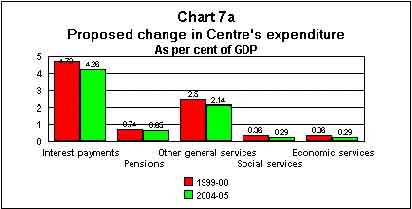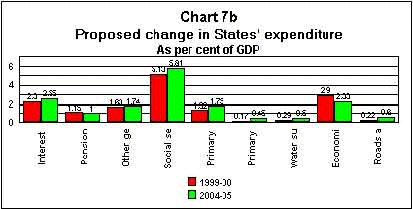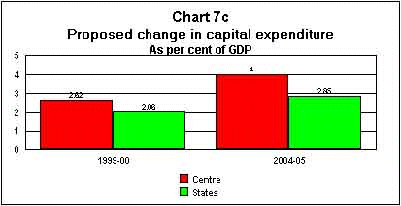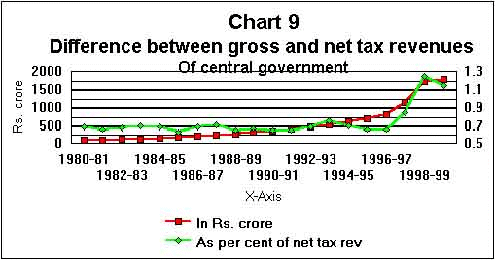|
There
is of course a more basic question. Raising tax-GDP
ratios requires more than just political will, which
is obviously a necessary condition. It also, in today's
world, implies a willingness to engage in macroeconomic
strategies which may not please potentially mobile capital.
It is not an accident that all finance capital dislikes
taxation; and recent experience suggests that the competitive
pressure to attract other forms of capital also typically
generates policies like tax incentives. Indeed, more
taxation is probably greater anathema to large capital
than the much-maligned large fiscal deficits.
The EFC's intentions in this regard are wholly laudable,
but there must be an explicit recognition of the implications,
which involve a redirection of the basic macroeconomic
strategy. Thus, the anticipated increases in income
tax and corporation tax, while entirely feasible at
one level, are not really compatible with a macroeconomic
approach that puts primacy on the need to attract inflows
of capital.
That the EFC is basically operating in that kind of
world is evident from the suggestions on expenditure
restraint. The largest element of Central revenue expenditure
today is interest payments, which the Report actually
describes as one of the items which is "inflexible downwards".
The EFC appears to suggest that the only way out of
this in future is to reduce public debt by cutting deficits
at present. But even changing the pattern of financing
the existing deficits can have a major effect on reducing
the interest burden of the government.
The EFC uncritically accepts the position that the government
has to rely only on expensive market borrowing and rules
out the possibility of deficit financing altogether,
even though this would sharply reduce interest payments
at the margin. Similarly it appears to accept that the
Statutory Liquidity Ratio cannot possibly be raised,
even though this would increase access to slightly cheaper
borrowing by the government. All this because the EFC
seems to subscribe to the position that public borrowing
"crowds out" private investment, even though empirical
studies in India and elsewhere suggest that there is
if anything a positive correlation between public and
private investment.
The constraints imposed by this approach mean that the
EFC is forced to rely on cuts in other expenditure to
move towards fiscal balance. Thus, as shown in Chart
7a, the Centre must makes cuts in the already pitifully
small proportions of GDP that are spent on social and
economic services, not to mention the declines in expenditure
(as share of GDP) slated for pensions and general services.

Chart
7a >> Click
to Enlarge

Chart
7b >> Click
to Enlarge

Chart
7c >> Click
to Enlarge
For the States - as described in Chart 7b - there are
to be small increases in the per cent of GDP expended
on social and general services, especially in some sub-categories,
but, alarmingly, a further cut in the proportion spent
on economic services. It is hard to imagine the justification
for such a cut by both Centre and States, especially
now that the myth that the private sector will enter
to fill such spending gaps has been well and truly exposed
by the Indian experience of the 1990s.
Of course, all these considerations, interesting as
they are, are of little immediate relevance since these
are no more than general policy suggestions which may
or may not be taken seriously by the Government, and
by the Finance Ministry in particular. But they are
important for our purposes because they inform the real
bread and butter issues of the EFC, that is the questions
of sharing tax revenues between Centre and States and
allocating across States. Thus, the EFC appears to be
so concerned with its own prescription of fiscal health
of the Centre that it has tailored the need for revenue
sharing with the States accordingly, despite the requirements
of greater fiscal federalism.
This is where the real disappointment with the Report
comes. Despite the crying need to devolve more resources
to the State level, which many would argue to be self-evident,
the EFC has actually set the clock backwards and moved
away from greater devolution, notwithstanding its statements
to the contrary.
At first sight, it appears that the EFC has actually
provided more resources from the Central pool. Thus
it has made provision for about 37.5 per cent of all
Union taxes and duties to be shared with State governments.
However, some of this relates to direct grants and support
by the Centre rather than the amounts which must be
statutorily shared, and therefore depends upon the discretion
of the Central government.
In terms of the statutory requirement, the EFC has been
much more restrained, and has ended up providing to
the States even less (as a proportion of total tax revenues)
than they have received at several points over the past
twenty years. This is clarified below.
One important respect in which a major demand of the
States has been neglected (again, because of the wording
of the Eightieth Amendment Act) has been in terms of
the sharing of net proceeds versus the gross tax revenues
of the Central government. The difference is not large,
and many would argue it to be inconsequential were it
not for the fact that the discrepancy has grown substantially
in the past few years, as plotted in Chart 9. Not only
does it mean that there is no incentive for the Centre
to be more efficient in terms of collecting its taxes,
but it effectively reduces the pool of resources for
the States.

Chart
8 >> Click to Enlarge

Chart
9 >> Click to Enlarge
The EFC has proposed that 28 per cent of the net tax
revenues of the Centre must be shared with the States.
As would be clear from an examination of Chart 8, this
is lower than the previous year and even lower than
the average for the entire decade. Of course, in addition
the EFC has also recommended that another 1.5 per cent
of the net proceeds be shared in lieu of the additional
excise duties which were effectively foregone after
the Eightieth Amendment Act. |

